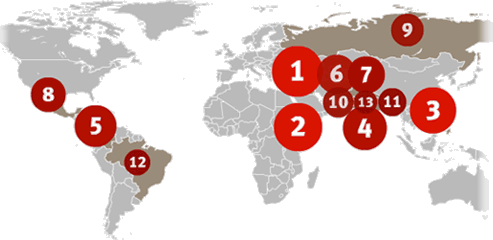Although the motives remained unconfirmed in late year, the murders of Chhattisgarh’s Umesh Rajput and Mumbai crime reporter Jyotirmoy Dey reminded colleagues of the risk of violence. India remained on CPJ’s Impunity Index, a ranking of countries in which journalists are murdered regularly and authorities fail to solve the crimes. Violent clashes between insurgents and government forces in states such as Kashmir challenged reporters’ ability to work. In a mid-year report, The Hoot, a media issues website, recorded nine journalist assaults between January and May, including four in Orissa, where industrialization and Maoists had each displaced local residents. Authorities retaliated against critical reporting with antistate charges: Two journalists were jailed for allegedly supporting rebels after they criticized the impact of anti-Maoist campaigns on civilians. Journalists who exposed police ineptitude and corruption faced jail time. Politicians and businessmen muzzled reporters with legal action, including defamation, which authorities failed to decriminalize. Internet penetration was relatively low but growing, prompting the government to pass regulations that could suppress online dissent.
India
» Impunity in journalist murders fosters further anti-press violence.
» Authorities nationwide allege antistate activity to justify media harassment.
Although the motives remained unconfirmed in late year, the murders of Chhattisgarh’s Umesh Rajput and Mumbai crime reporter Jyotirmoy Dey reminded colleagues of the risk of violence. India remained on CPJ’s Impunity Index, a ranking of countries in which journalists are murdered regularly and authorities fail to solve the crimes. Violent clashes between insurgents and government forces in states such as Kashmir challenged reporters’ ability to work. In a mid-year report, The Hoot, a media issues website, recorded nine journalist assaults between January and May, including four in Orissa, where industrialization and Maoists had each displaced local residents. Authorities retaliated against critical reporting with antistate charges: Two journalists were jailed for allegedly supporting rebels after they criticized the impact of anti-Maoist campaigns on civilians. Journalists who exposed police ineptitude and corruption faced jail time. Politicians and businessmen muzzled reporters with legal action, including defamation, which authorities failed to decriminalize. Internet penetration was relatively low but growing, prompting the government to pass regulations that could suppress online dissent.
-
13th
Impunity Index ranking, 2011 -
2
Imprisoned on December 1, 2011 -
10
Killed in Kashmir since 1992 -
2
Pledges to decriminalize defamation -
11
Blocked websites
Seven murders from the past decade remain unsolved, making India one of the worst countries in the world at combating deadly anti-press violence, CPJ's Impunity Index showed.

| 1. Iraq 2. Somalia 3. Philippines 4. Sri Lanka | 5. Colombia 6. Afghanistan 7. Nepal 8. Mexico | 9. Russia 10. Pakistan 11. Bangladesh 12. Brazil | 13. India |
Freelancer Lingaram Kodopi documented anti-Maoist violence by police in Chhattisgarh. Mumbai magazine editor Sudhir Dhawale criticized Chhattisgarh's anti-insurgent militia. Both journalists awaited trial in late year on retaliatory charges.
2
Relatives of Kodopi hospitalized in Chhattisgarh during 2011--one after being beaten in police custody, one after being shot by Maoists, according to Frontline magazine.88
Books belonging to Dhawale that police confiscated without a warrant to demonstrate Maoist sympathies, according to his supporters, who say he was framed.The state’s historically poor press freedom record declined again after violence contesting Indian rule during the summer of 2010 brought tighter government restrictions.
A chokehold on coverage:
5,000: Subscribers to an SMS news service that were affected when a June 2010 government blockage was extended into 2011. Officials later reinstated non-journalistic SMS services.
5: Kashmir newspapers denied government advertising for “anti-national” riot coverage, India Today reported.
0: Journalists interviewed in February by the weekly Tehelka who said police had honored curfew passes allowing them to report during times of restricted movements.
5: Journalists covering protests who were assaulted or detained by authorities in August and November--Al-Jazeera contributor Showkat Shafi both times.
2: Journalists refused entry. U.S.-based Alternative Radio’s David Barsamian, known for his analyses of Kashmir, was turned back at New Delhi airport; and Gautam Navlakha, editorial consultant of Economic and Political Weekly, was sent home to New Delhi from the summer capital, Srinagar.
In January, M. Veerappa Moily, minister of law, and in February, Ambika Soni, minister of information and broadcasting, promised journalists that decriminalization was forthcoming. It did not materialize in 2011.
1
Night in jail spent by Prabhatkiran cartoonist Harish Yadev after Muslims took offense to his drawing of a politician. Prabhatkiran said the politician instigated the complaints, Hindustan Times reported.6
Gujarat police who summoned journalist Rahul Singh to court in January for tampering with evidence. Singh had exposed a mass grave of 2002 Gujarat riot victims, Open magazine reported.5
Days in detention spent by Tarakant Dwivedi under the Official Secrets Act after he detailed faulty weapons storage in a Mumbai Mirror article.Two U.S.-based news sites, Indymedia and IndyBay, were among those that Bangalore’s Center for Internet and Society found had been blocked domestically in April. Critics said new regulations banning ill-defined “harmful” online content could increase censorship.
